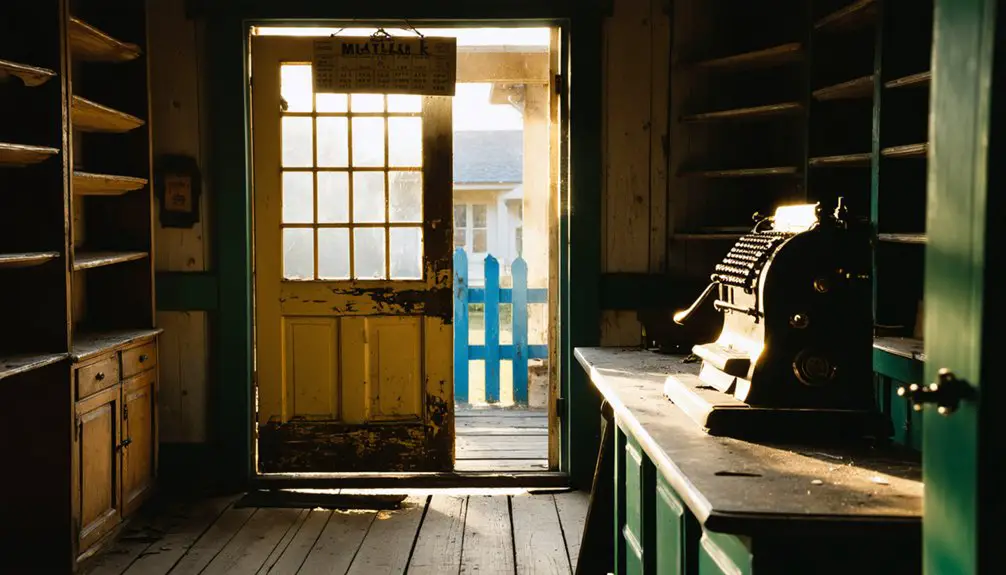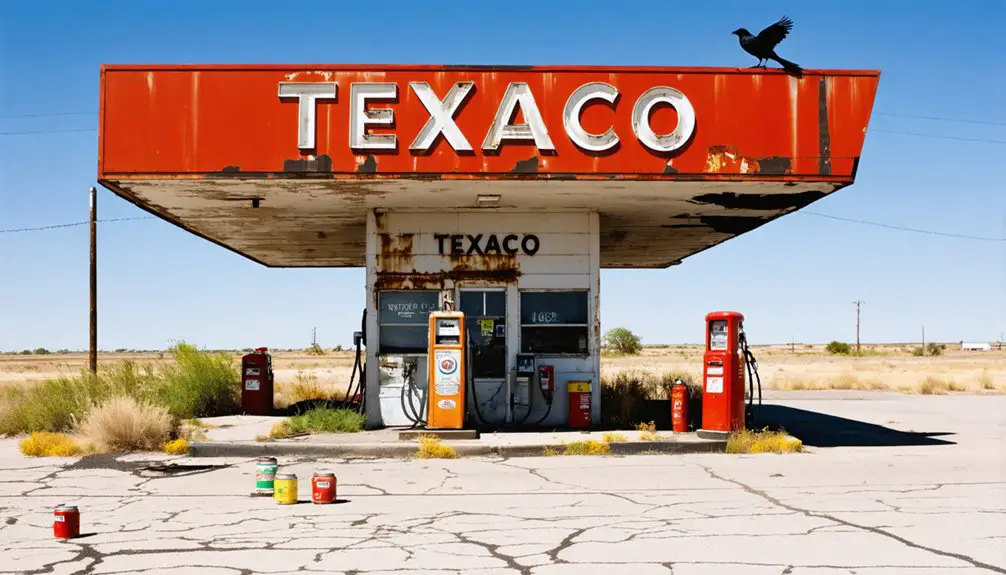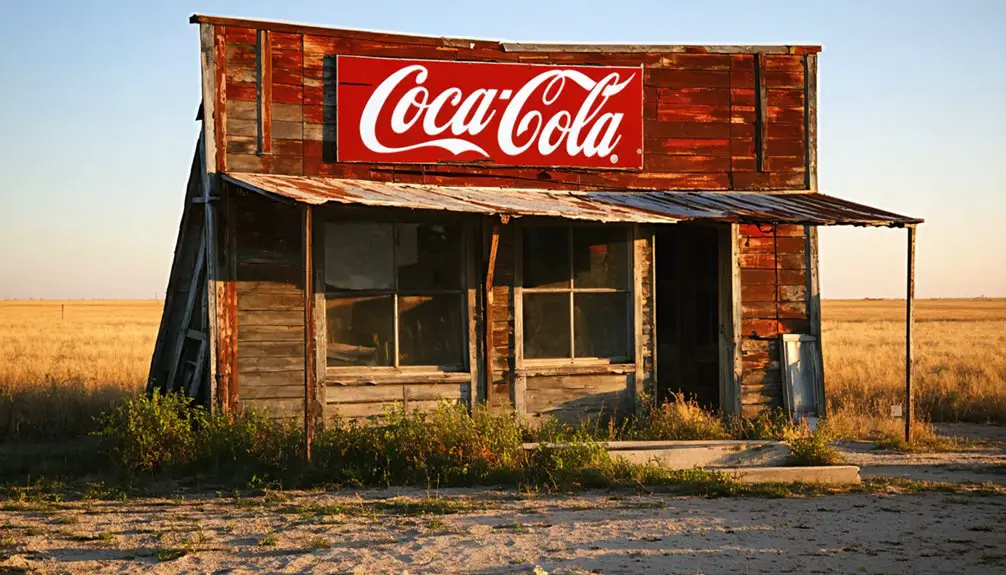You’ll find Empire, Oklahoma near Bartlesville, where it emerged as an oil boomtown in the early 1900s during the Black Gold Rush. The town flourished with wooden buildings, derricks, and a bustling community of oil workers, their families, and supporting businesses. After transportation patterns shifted and urbanization drew residents away, Empire declined into a ghost town. Today, deteriorating structures and rusted industrial remnants offer glimpses into Oklahoma’s petroleum-rich past.
Key Takeaways
- Empire, Oklahoma emerged as an oil boomtown in the early 1900s during Oklahoma’s Black Gold Rush era.
- The town’s economy centered around oil production, with diverse workers including drillers, roughnecks, and roustabouts.
- Transportation route changes and shifting economic patterns led to Empire’s decline and eventual ghost town status.
- Deteriorating wooden structures, rusted industrial remnants, and concrete foundations remain as evidence of the former boomtown.
- Native vegetation and wildlife now reclaim the abandoned town space, while toxic contamination persists from oil operations.
The Birth of an Oil Boomtown
While the discovery of oil in Oklahoma transformed many settlements into boomtowns, Bartlesville emerged as the state’s pioneering oil center after the successful drilling of Nellie Johnstone No. 1 in 1897.
You’ll find that early oil exploration faced significant challenges, including dangerous crude overflow and fires that threatened operations. The town’s growth accelerated when Michael Cudahy secured extensive leases in 1894. Life was particularly hazardous for workers who faced dangerous drilling conditions in the emerging oilfields.
The game-changer came in 1899 when the Kansas, Oklahoma Central and Southwestern Railway connected Bartlesville to Neodesha. This crucial infrastructure sparked an unprecedented rush of oilmen to the region, instantly altering the boomtown dynamics.
The arrival of rail service in 1899 revolutionized Bartlesville’s oil industry, transforming a remote settlement into a bustling energy hub.
The tiny settlement of 200 residents quickly evolved into a thriving hub of commerce and industry. Located just 18 miles from the Kansas border and under 50 miles from Tulsa, Bartlesville’s strategic position helped cement its role in Oklahoma’s emerging oil empire.
Life During the Black Gold Rush
The Black Gold Rush transformed every aspect of Oklahoma life, from its economy to its social fabric. You’d find stark economic fluctuations, with personal fortunes made and lost as oil prices swung dramatically – dropping from $1.56 to just 16 cents per barrel by 1931.
During this volatile period, community dynamics shifted rapidly as boomtowns emerged, filled with oil workers, their families, and supporting businesses. Makeshift living conditions dominated these settlements as workers and families adapted to the rapid growth. Like the California Gold Rush of 1848, the oil boom triggered a mass migration of people seeking opportunity.
During this volatile period, community dynamics shifted rapidly as boomtowns emerged, filled with oil workers, their families, and supporting businesses.
You would’ve witnessed a clear social divide between wealthy oil barons and laborers, while roughnecks endured dangerous conditions in the fields.
Women and children played essential support roles in these bustling communities. Governor Murray even declared martial law to control production and preserve reserves.
Life centered around the wells, creating a distinct “black gold” culture that defined Oklahoma’s identity during this transformative era.
Architecture and Infrastructure
Walking through Empire City today, you’ll see few traces of its earliest wooden buildings, which were hastily constructed during the oil boom using locally sourced lumber.
The town’s infrastructure centered around its oil operations, with derricks, pipelines, and storage tanks once dominating the landscape, though only scattered ruins of these industrial elements remain.
The railroad station, originally built with the same red brick as the town’s school, served as an essential transportation hub but has since disappeared, leaving only traces of the rail bed where tracks once connected Empire City to larger markets.
Like many Oklahoma ghost towns that faced environmental challenges, Empire City’s remaining structures show signs of toxic contamination from decades of industrial activity.
Similar to Kusa’s experience, the town’s fortunes shifted dramatically when transportation routes changed, leading to its eventual decline.
Early Wooden Building Styles
During Oklahoma’s territorial period, settlers and Native Americans primarily constructed wooden buildings using log construction methods derived from Appalachian vernacular styles.
You’ll find these early structures featured simple rectangular floor plans with gabled roofs and external chimneys built of stone or brick. The most adaptable design was the dogtrot house, with its signature open breezeway that provided natural cooling during hot summers. John Brooks Walton’s expertise in traditional architecture later helped document these historic building styles.
As settlements grew, you’d see variations emerge. Some homes expanded from single-room cabins to “saddlebag” or “Cumberland” designs, while affluent Native leaders incorporated refined elements like finished siding and oak doors. The wealthy Cherokee leaders often ordered furnishings from New Orleans to decorate their antebellum homes.
Large covered porches became standard features, offering shade and outdoor living space, while elevated foundations protected the structures from ground moisture and pests common to eastern Oklahoma.
Oil Infrastructure Remnants
While early wooden structures defined Empire’s initial development, rusted steel giants now dominate the ghost town’s landscape.
You’ll find skeletal oil derricks rising from the Oklahoma soil, their weathered frameworks standing as silent sentinels of a bustling past. Empire’s quick oil boom sparked rapid development before its eventual decline into abandonment. Similar to Picher’s rapid population decline, Empire’s transition from thriving industry to ghost town mirrors other Oklahoma boomtowns.
Pipeline remnants crisscross the terrain, marked by cleared corridors and corroded steel tubes that once carried crude oil and natural gas.
Throughout Empire’s former oil fields, you’ll discover:
- Iconic horsehead pumpjacks frozen in time, surrounded by scattered drill bits and rusted pipe wrenches
- Circular concrete foundations where massive storage tanks once held crude oil, bordered by earthen containment berms
- Service building remnants including repair shop foundations, scale house ruins, and water tower bases that supported the town’s industrial operations
Railroad Station Architecture
The architectural grandeur of Empire’s railroad stations once reflected the early 20th-century prosperity of Oklahoma’s oil boom.
You’ll find the railroad design incorporated Mission Revival and Spanish Colonial Revival styles, featuring stucco walls, red tile roofs, and ornamental courtyards that showcased the region’s architectural significance.
The stations’ layout revealed the complex social dynamics of the era through segregated waiting rooms, while maintaining efficient passenger flow via tunnels and underpasses.
You can still trace the practical infrastructure that seamlessly connected street-level operations to multiple train platforms.
Major railways like the MKT, Rock Island, and Frisco served Empire’s station, integrating both passenger comfort and freight handling capabilities.
Behind the main passenger facilities, warehouses and material handling zones facilitated smooth logistics operations.
Notable Residents and Local Stories

While detailed records of Empire’s prominent citizens haven’t survived, the town’s population primarily consisted of oil workers and their families who faced the boom-and-bust cycle typical of Oklahoma’s resource towns.
You’ll find that local stories mirror those of nearby ghost towns like Whizbang, where residents endured challenging conditions in pursuit of opportunity during the oil boom years.
The social fabric of Empire centered around communal gathering spots like churches and dance halls, where workers and families forged brief but intense connections before economic changes forced them to move on.
Pioneer Family Life Stories
Settling into Empire’s untamed frontier during the early 20th century, pioneer families faced daily challenges that shaped their resilient character and forged lasting community bonds.
You’ll find their pioneer resilience reflected in the self-built wooden homes and sod houses that dotted the landscape, where family traditions centered around survival and mutual support.
Daily life in Empire revolved around three essential activities:
- Working the land through farming and animal husbandry
- Gathering at the local church and schoolhouse for social events and community meetings
- Sharing resources and labor during barn raisings, harvests, and times of hardship
These families’ stories live on through oral histories, telling tales of surviving harsh winters, establishing crucial businesses, and building the foundations of a community that, though now gone, exemplified the spirit of Oklahoma’s frontier.
Notable Oil Workers
Beyond the steadfast pioneer families who built Empire’s foundations, a new wave of ambitious oil workers transformed the town’s character in the early 1900s. Among these pioneers, James Kessler embodied the quintessential oil worker achievement, rising from humble beginnings to establish the influential Kessler Petroleum Corporation, which operated across Oklahoma, Texas, and New Mexico.
The oil fields drew a diverse workforce of immigrant contributions, including specialized drillers, roughnecks, and roustabouts who braved dangerous conditions for the chance at economic advancement.
You’ll find their legacy in stories of tremendous physical courage – facing toxic gases, well blowouts, and grueling labor. While many workers lived transient lives, moving between boomtowns like Empire and Whizbang, they created a distinctive culture marked by toughness and camaraderie that defined Oklahoma’s early oil era.
Local Legends Live On
Throughout Empire’s brief but vibrant history, the town’s most compelling stories emerged from its diverse cast of local characters who shaped its identity during the 1910s oil boom.
Today, you’ll find their legacy woven into the rich folklore significance of this Oklahoma ghost town.
The storytellers and local historians have preserved these tales through generations:
- Pioneer families who established the first businesses during the oil boom, with their names still appearing in regional genealogical records.
- Merchants and service providers who kept the town’s commerce alive, organizing community events and social gatherings.
- Local residents who’ve passed down accounts of ghostly encounters in abandoned buildings, adding to the mysterious allure that draws curious visitors to Empire’s remains.
The Beginning of Decline

When the early signs of Empire’s decline emerged in the mid-20th century, several key factors converged to seal the town’s fate.
You could see the decline factors taking shape as transportation patterns shifted dramatically, bypassing the once-bustling community and redirecting essential traffic flows elsewhere. Economic downturns hit particularly hard, following the boom-and-bust pattern that plagued many Oklahoma towns of the era.
Like countless other small communities across the state, Empire couldn’t withstand the powerful forces of urbanization drawing residents toward larger cities.
Small Oklahoma towns like Empire fell victim to urbanization’s relentless pull, as residents abandoned rural life for metropolitan opportunities.
The changing landscape of American transportation, with new interstate highways reshaping travel patterns, dealt a significant blow to Empire’s commercial importance. As businesses shuttered and residents sought opportunities elsewhere, the town’s infrastructure began its slow descent into disrepair.
Remaining Structures Today
As you explore Empire’s remnants today, you’ll find a haunting collection of deteriorating structures that tell the story of Oklahoma’s oil boom era. The remaining structures of this ghost town stand as weathered sentinels of a bygone age, slowly surrendering to nature’s persistent reclamation.
- Wood-framed homes and commercial buildings from the early 20th century remain partially standing, their architectural styles reflecting the oil boom period, though most lack roofs and windows.
- Rusted remnants of industrial infrastructure dot the landscape, including old oil derricks, storage tanks, and concrete foundations.
- Former transportation routes crisscross the area, with deteriorating roadways and possible railroad siding ruins visible among scattered vehicle remains and crumbling service stations.
Wildlife now claims these spaces, while native vegetation steadily engulfs the structural remains.
Historical Preservation Efforts

Since the decline of Empire’s oil industry, Oklahoma’s State Historic Preservation Office (SHPO) has spearheaded extensive efforts to protect and document the town’s remaining heritage.
Through “Tomorrow’s Legacy,” SHPO’s statewide preservation plan, you’ll find thorough preservation strategies that include photographic documentation, oral history collection, and site evaluation of Empire’s historic structures.
Community involvement plays a crucial role in these preservation efforts. You can participate in public exhibits and digital outreach programs that share Empire’s story, while local preservation offices work with property owners to protect privately held historic sites.
Despite challenges from potential federal budget cuts to the Historic Preservation Fund, SHPO continues collaborating with the Oklahoma Historical Society and national preservation groups to guarantee Empire’s oil boom legacy endures for future generations.
Legacy in Oklahoma’s Oil History
During Oklahoma’s transformative oil rush of the early 1900s, Empire emerged as a quintessential boomtown that helped shape the state’s petroleum industry.
As oil exploration intensified near Duncan, Empire’s rapid growth mirrored the broader economic impact sweeping across Oklahoma’s oil-rich territories.
The town’s legacy in Oklahoma’s petroleum history is marked by:
- Contributing to the state’s emergence as a national leader in oil production, particularly following major discoveries like Glenn Pool in 1905.
- Supporting the expansion of critical infrastructure, including pipelines and railroads that connected local fields to larger markets.
- Demonstrating the volatile nature of oil-dependent economies, as the town’s population fluctuated from near abandonment to nearly 1,000 residents by 2010.
You’ll find Empire’s story woven into Oklahoma’s larger narrative of resource-driven development and boom-and-bust cycles.
Frequently Asked Questions
Are There Any Reported Paranormal Activities or Ghost Sightings in Empire?
You won’t find documented ghost encounters or spectral sightings in Empire. Unlike other Oklahoma ghost towns with paranormal reputations, there aren’t any verified reports of supernatural activity in this location.
What Was the Highest Recorded Population During Empire’s Peak Years?
You’ll find Empire’s highest recorded population reached 3,000 residents during its population growth in the late 1910s to early 1920s, marking its historical significance as a thriving oil boom town.
Did Empire Have Its Own Newspaper or Local Media Outlet?
Despite nearby Duncan having 3+ newspapers since 1892, you won’t find historical archives showing Empire had its own local journalism outlet. You’d have relied on The Duncan Banner for news coverage.
Were There Any Major Crimes or Lawlessness Incidents During the Boom?
You won’t find reliable crime statistics for Empire, as local law enforcement records are scarce. While typical boomtown disorders likely occurred, there’s no documented evidence of major criminal incidents.
What Indigenous Tribes Originally Inhabited the Land Where Empire Was Built?
You’ll find the Comanche and Kiowa tribes originally claimed this tribal history, with both nations having significant land significance in what later became Empire’s territory in southwestern Oklahoma.
References
- https://en.wikipedia.org/wiki/List_of_ghost_towns_in_Oklahoma
- https://www.youtube.com/watch?v=5d-wHDTIbb0
- https://nondoc.com/2022/01/04/whizbang-oklahoma-ghost-town/
- https://www.okhistory.org/publications/enc/entry?entry=GH002
- https://okmag.com/blog/a-ghostly-site/
- https://www.okhistory.org/publications/enc/entry?entry=PE023
- https://samnoblemuseum.ou.edu/permanent-exhibits/conoco-oil-pioneers-of-oklahoma-plaza/
- https://aoghs.org/old-oil-stocks/old-oil-stocks-progress-e/
- https://www.islands.com/1875963/oklahoma-first-oil-boomtown-thriving-historic-city-unioque-shopping-world-class-museums/
- https://econisok.org/wp-content/uploads/Great-Oklahoma-Gold-Rush.pdf



